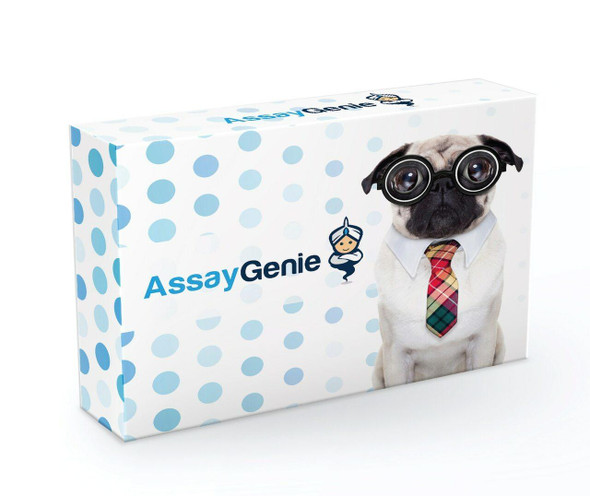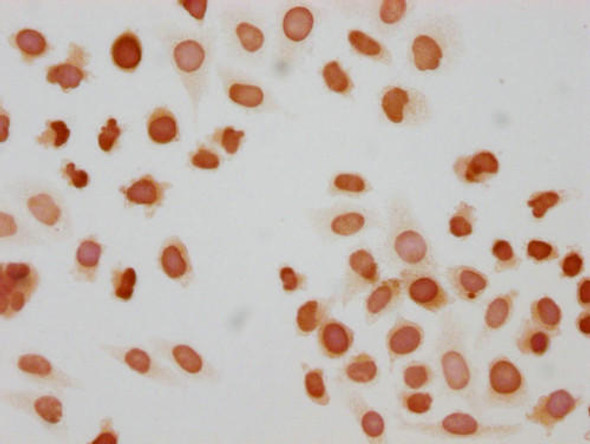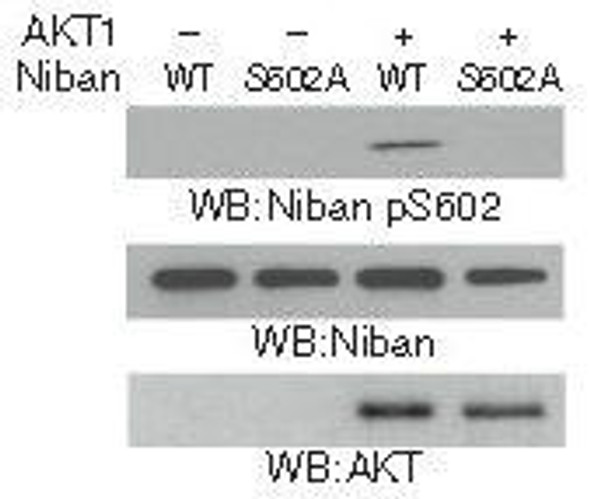Description
Phospho-DMTN (S403) Antibody (PACO03624)
The Phospho-DMTN (S403) Antibody (PACO03624) is a valuable tool for researchers studying the phosphorylation of DMTN, a protein involved in cellular processes. This polyclonal antibody, derived from rabbit hosts, is highly specific to human samples and has been validated for use in Western blot applications. By binding to the phosphorylated form of DMTN at Serine 403, this antibody allows for the detection and analysis of this important protein modification in various cell types.DMTN, also known as dematin, is a cytoskeletal protein that plays a role in cell shape and movement. Phosphorylation of DMTN at Serine 403 may regulate its function, impacting cellular processes such as adhesion and migration.
Research on phosphorylation events like this one is essential for understanding cell signaling pathways and their implications in physiological and pathological conditions.The Phospho-DMTN (S403) Antibody is a valuable tool for investigating the role of DMTN phosphorylation in various cellular processes, making it ideal for studies in cell biology, signal transduction, and disease mechanisms. By elucidating the function of phosphorylated DMTN, researchers can gain insights into potential therapeutic targets for diseases where abnormal cell signaling and cytoskeletal dynamics contribute to pathology.
| Antibody Name: | Phospho-DMTN (S403) Antibody |
| Antibody SKU: | PACO03624 |
| Size: | 50ug |
| Host Species: | Rabbit |
| Tested Applications: | ELISA, WB, IHC |
| Recommended Dilutions: | WB:1:500-1:2000, IHC:1:100-1:300 |
| Species Reactivity: | Human, Mouse |
| Immunogen: | synthesized peptide derived from human Dematin around the phosphorylation site of S403. |
| Form: | Liquid |
| Storage Buffer: | Liquid in PBS containing 50% glycerol, 0.5% BSA and 0.02% sodium azide. |
| Purification Method: | The antibody was affinity-purified from rabbit antiserum by affinity-chromatography using epitope-specific immunogen. |
| Clonality: | Polyclonal |
| Isotype: | IgG |
| Conjugate: | Non-conjugated |
| Synonyms: | EPB49; DMT; Dematin; Erythrocyte membrane protein band 4.9 |
| UniProt Protein Function: | dematin: a probable DNA binding protein, with a Myb-like DNA-binding and ELM2 domain. |
| UniProt Protein Details: | Protein type:Motility/polarity/chemotaxis; Tumor suppressor; Actin-binding Chromosomal Location of Human Ortholog: 8p21.1 Cellular Component: actin cytoskeleton; actin filament; cell projection membrane; cortical cytoskeleton; cytoplasmic membrane-bound vesicle; cytosol; endomembrane system; perinuclear region of cytoplasm; plasma membrane Molecular Function:actin binding; protein binding; protein self-association; receptor binding; spectrin binding Biological Process: actin cytoskeleton organization and biogenesis; actin filament bundle formation; actin filament capping; cytoskeleton organization and biogenesis; erythrocyte development; negative regulation of focal adhesion formation; negative regulation of peptidyl-serine phosphorylation; negative regulation of peptidyl-tyrosine phosphorylation; positive regulation of blood coagulation; protein complex assembly; regulation of actin cytoskeleton organization and biogenesis; regulation of cell shape; regulation of filopodium formation; transmembrane transport |
| NCBI Summary: | The protein encoded by this gene is an actin binding and bundling protein that plays a structural role in erythrocytes, by stabilizing and attaching the spectrin/actin cytoskeleton to the erythrocyte membrane in a phosphorylation-dependent manner. This protein contains a core domain in the N-terminus, and a headpiece domain in the C-terminus that binds F-actin. When purified from erythrocytes, this protein exists as a trimer composed of two 48 kDa polypeptides and a 52 kDa polypeptide. The different subunits arise from alternative splicing in the 3' coding region, where the headpiece domain is located. Disruption of this gene has been correlated with the autosomal dominant Marie Unna hereditary hypotrichosis disease, while loss of heterozygosity of this gene is thought to play a role in prostate cancer progression. Alternative splicing results in multiple transcript variants encoding different isoforms. [provided by RefSeq, Nov 2014] |
| UniProt Code: | Q08495 |
| NCBI GenInfo Identifier: | 22654240 |
| NCBI Gene ID: | 2039 |
| NCBI Accession: | Q08495.3 |
| UniProt Secondary Accession: | Q08495,Q13215, Q9BRE3, A8K0T5, B3KP70, B3KRH3, B4DI75 E9PEJ0, |
| UniProt Related Accession: | Q08495 |
| Molecular Weight: | 41,558 Da |
| NCBI Full Name: | Dematin |
| NCBI Synonym Full Names: | dematin actin binding protein |
| NCBI Official Symbol: | DMTN |
| NCBI Official Synonym Symbols: | DMT; EPB49 |
| NCBI Protein Information: | dematin |
| UniProt Protein Name: | Dematin |
| UniProt Synonym Protein Names: | Dematin actin-binding protein; Erythrocyte membrane protein band 4.9 |
| Protein Family: | Dematin |
| UniProt Gene Name: | DMTN |
| UniProt Entry Name: | DEMA_HUMAN |











